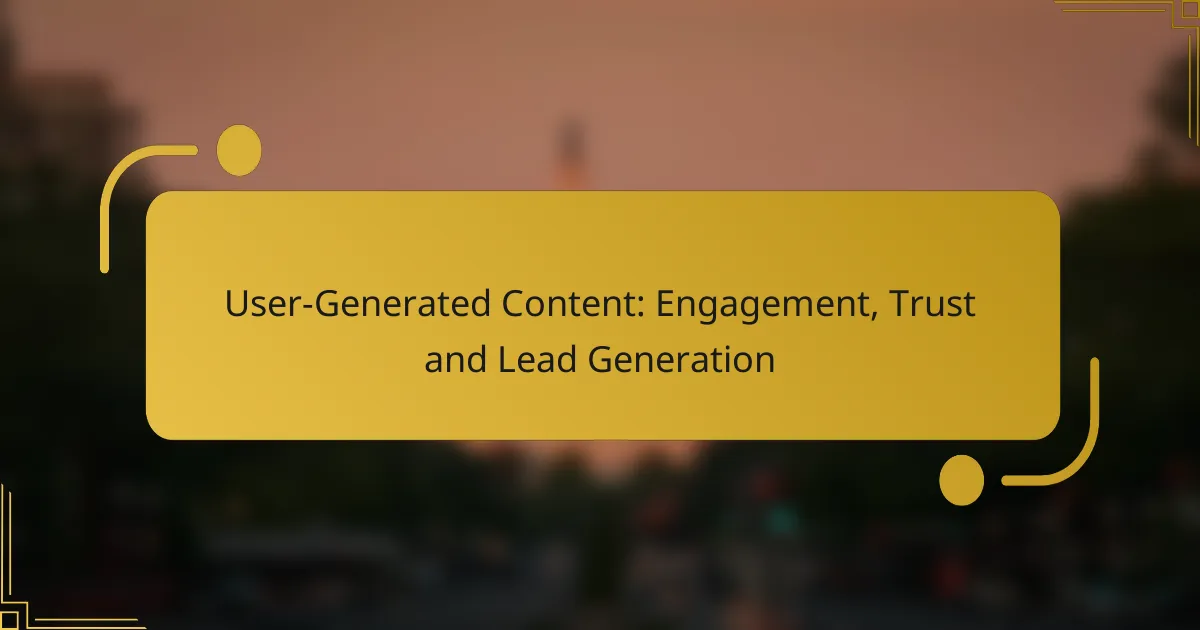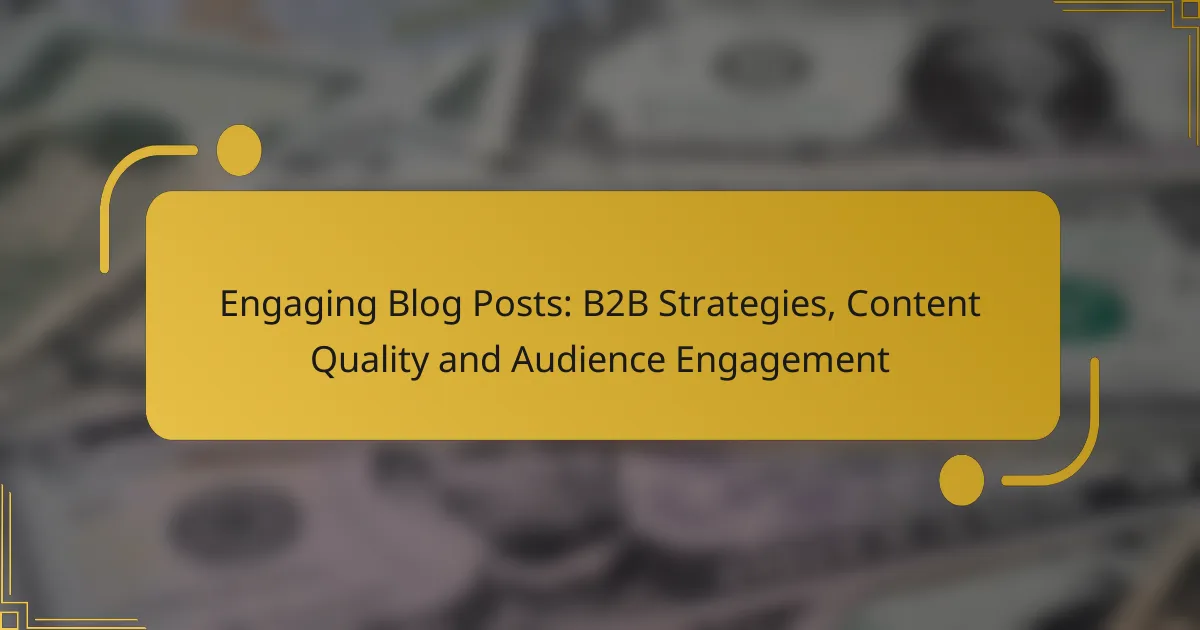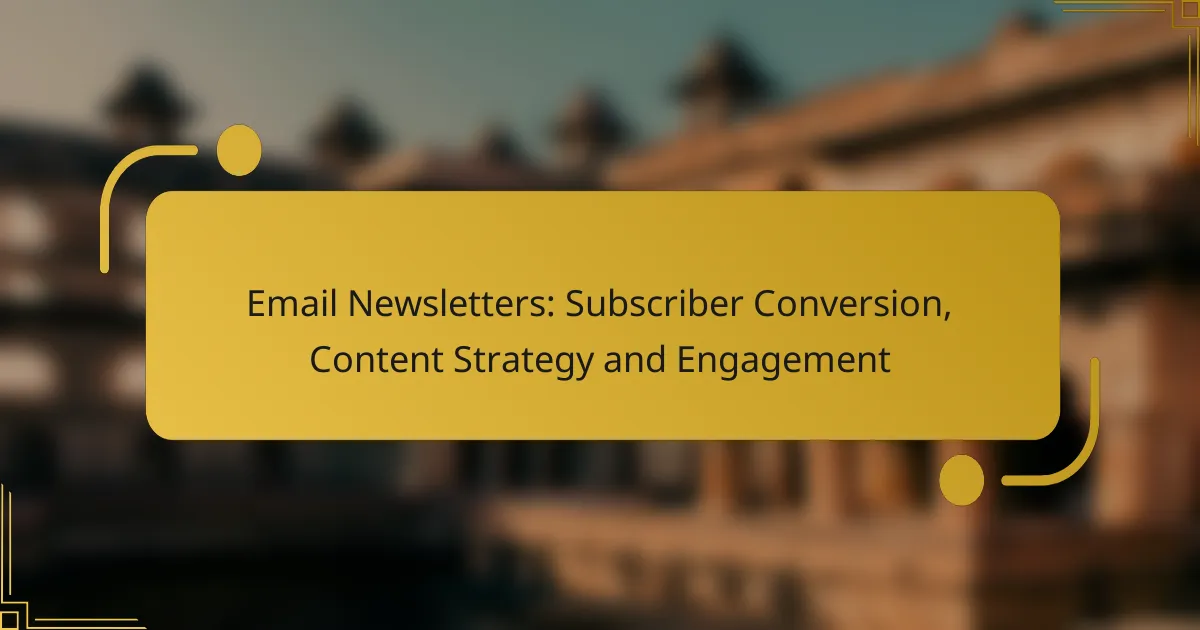User-generated content (UGC) plays a crucial role in modern marketing by enhancing engagement, building trust, and generating leads. By showcasing authentic experiences from real customers, UGC fosters meaningful connections and encourages participation, leading to increased brand affinity. This approach not only enhances credibility but also attracts potential customers, ultimately driving conversions and business growth.

How does user-generated content enhance engagement in marketing?
User-generated content (UGC) significantly boosts engagement in marketing by fostering authentic connections between brands and consumers. It encourages participation, facilitates dialogue, and creates a sense of community, which can lead to higher interaction rates and brand affinity.
Increased audience interaction
User-generated content invites audiences to participate actively in brand conversations, leading to increased interaction. When customers share their experiences or opinions, it creates a dialogue that brands can leverage to connect with their audience on a personal level.
Encouraging customers to post reviews, photos, or videos can lead to a more vibrant online community. Brands can enhance this interaction by featuring user content on their platforms, which not only acknowledges the contributors but also motivates others to engage.
Improved brand loyalty
When customers see their contributions valued by a brand, it fosters a sense of belonging and loyalty. User-generated content can create emotional connections, making customers feel more invested in the brand’s success.
To cultivate loyalty, brands should regularly showcase user content and acknowledge contributors. Implementing loyalty programs that reward customers for sharing their experiences can further strengthen this bond, encouraging repeat engagement.
Higher social media shares
User-generated content tends to be shared more frequently on social media platforms, amplifying brand reach. Authentic content resonates well with audiences, making them more likely to share it with their networks.
Brands can enhance shareability by creating campaigns that encourage users to share their content using specific hashtags or by tagging the brand. This not only increases visibility but also attracts new customers who may discover the brand through their friends’ posts.

What role does user-generated content play in building trust?
User-generated content (UGC) significantly enhances trust by showcasing authentic experiences and opinions from real customers. This type of content fosters a sense of credibility and connection, making potential customers more likely to engage with a brand.
Authenticity through real experiences
Authenticity is a key factor in building trust, and user-generated content provides genuine insights into customer experiences. When potential buyers see real people sharing their stories, it creates a relatable narrative that resonates more than traditional advertising.
For instance, a clothing brand featuring photos and testimonials from actual customers can effectively demonstrate how their products fit into everyday life. This approach not only highlights the product’s quality but also encourages others to share their experiences, further enhancing authenticity.
Social proof from customer reviews
Customer reviews serve as powerful social proof, influencing the decisions of prospective buyers. When potential customers see positive feedback from others, it reassures them about the quality and reliability of a product or service.
Encouraging satisfied customers to leave reviews on platforms like Google or social media can significantly boost a brand’s reputation. Aiming for a high volume of reviews can create a perception of trustworthiness, especially when the feedback is overwhelmingly positive.
Transparency in brand communication
Transparency in communication is essential for building trust through user-generated content. Brands that openly share customer feedback, both positive and negative, demonstrate their commitment to accountability and improvement.
For example, a company that responds to negative reviews with constructive dialogue shows potential customers that they value feedback and are willing to make changes. This openness can lead to increased customer loyalty and a stronger brand image.

How can businesses leverage user-generated content for lead generation?
Businesses can effectively leverage user-generated content (UGC) to generate leads by building trust and engagement with potential customers. By showcasing authentic experiences and feedback from existing customers, companies can attract new prospects and encourage conversions.
Encouraging customer testimonials
Encouraging customer testimonials is a powerful way to utilize user-generated content for lead generation. Testimonials provide social proof, which can significantly influence potential buyers’ decisions. Businesses should actively request feedback from satisfied customers and display these testimonials prominently on their websites and marketing materials.
To maximize impact, consider using video testimonials, as they can convey emotion and authenticity more effectively than text alone. Aim to collect testimonials that highlight specific benefits or results, making them relatable to prospective customers.
Utilizing social media campaigns
Social media campaigns can harness user-generated content to engage audiences and generate leads. Encourage customers to share their experiences with your products or services on platforms like Instagram, Facebook, or TikTok using a specific hashtag. This not only increases brand visibility but also fosters a sense of community among users.
Incorporate user-generated posts into your marketing strategy by featuring them on your brand’s social media pages or website. Consider running contests or giveaways that incentivize customers to share their content, which can further amplify reach and engagement.
Incorporating user content in email marketing
Incorporating user-generated content in email marketing can enhance engagement and drive conversions. Including customer photos, reviews, or testimonials in your email campaigns can make your messages more relatable and trustworthy. This approach can lead to higher open and click-through rates.
When designing email campaigns, consider segmenting your audience to tailor the user-generated content to specific groups. Highlighting relevant testimonials or user stories can resonate more with recipients, increasing the likelihood of lead generation. Aim to feature a mix of content types to keep emails fresh and engaging.

What are the best practices for encouraging user-generated content?
Encouraging user-generated content (UGC) involves creating an environment where users feel motivated to share their experiences and opinions. Effective strategies include engaging contests, offering incentives, and fostering a strong community around your brand.
Creating engaging contests
Contests are a powerful way to stimulate user-generated content. They can take various forms, such as photo competitions, video challenges, or storytelling contests, which invite users to showcase their creativity related to your brand.
To maximize participation, ensure the contest is easy to enter and has clear guidelines. Promote the contest across your social media channels and website to reach a broader audience. Consider highlighting user submissions to encourage others to participate.
Offering incentives for contributions
Incentives can significantly boost user engagement and content creation. These can range from discounts and gift cards to exclusive access or recognition on your platform. By providing tangible rewards, you motivate users to contribute their content.
When implementing incentives, be transparent about what users can expect. For example, if you offer a prize for the best submission, clearly outline the criteria and selection process to maintain trust and excitement.
Building a community around the brand
Creating a sense of community encourages users to share their experiences and content. This can be achieved through interactive social media groups, forums, or regular events where users can connect and engage with each other and the brand.
Foster open communication and actively participate in discussions to make users feel valued. Highlighting user stories and contributions can further strengthen community ties, encouraging more individuals to share their content and experiences with your brand.

What metrics should be tracked to measure the impact of user-generated content?
To effectively measure the impact of user-generated content (UGC), focus on metrics that reflect engagement, conversion, and acquisition. Key metrics include engagement rates on social media, conversion rates from user content, and customer acquisition costs, which together provide a comprehensive view of UGC’s effectiveness.
Engagement rates on social media
Engagement rates on social media indicate how well user-generated content resonates with your audience. This can include likes, shares, comments, and overall interaction with posts featuring UGC. A strong engagement rate, often in the range of 1-5%, suggests that users find the content relatable and valuable.
To track engagement, use analytics tools provided by platforms like Facebook, Instagram, and Twitter. Regularly monitor these metrics to identify trends and adjust your content strategy accordingly. Aim to encourage more interaction by asking questions or prompting discussions in your UGC posts.
Conversion rates from user content
Conversion rates from user-generated content measure how effectively this content drives desired actions, such as purchases or sign-ups. A typical conversion rate for UGC can vary widely but is often higher than traditional marketing content, sometimes reaching 10-20%. This indicates that potential customers trust peer-generated content more than brand messages.
To optimize conversion rates, ensure that UGC is prominently featured on product pages or in marketing emails. Use clear calls-to-action alongside user content to guide potential customers towards making a decision. Analyze which types of UGC lead to the highest conversions to refine your approach.
Customer acquisition costs
Customer acquisition costs (CAC) reflect the total expense incurred to acquire a new customer, including marketing and advertising costs. When leveraging user-generated content, CAC can decrease significantly, as UGC often requires less investment compared to traditional advertising methods. A reduction in CAC can be a strong indicator of UGC’s effectiveness.
To calculate CAC, divide your total marketing expenses by the number of new customers acquired during a specific period. Keep track of how UGC impacts these costs over time, and consider adjusting your budget to allocate more resources towards UGC strategies that yield lower acquisition costs.

How can user-generated content be integrated into content marketing strategies?
User-generated content (UGC) can be effectively integrated into content marketing strategies by leveraging customer-created materials to enhance engagement and build trust. This approach not only showcases authentic experiences but also encourages potential customers to connect with your brand.
Encouraging customer participation
To successfully incorporate UGC, brands should actively encourage customer participation through contests, hashtags, or dedicated platforms. For example, a clothing retailer might run a photo contest where customers share their outfits on social media using a specific hashtag. This not only generates content but also fosters a sense of community among customers.
Showcasing UGC on various platforms
Once UGC is collected, it can be showcased across multiple platforms such as websites, social media, and email newsletters. Highlighting customer reviews, testimonials, or photos on your website can enhance credibility and attract new customers. For instance, displaying user photos on product pages can lead to higher conversion rates.
Measuring the impact of UGC
Measuring the impact of user-generated content is crucial for understanding its effectiveness in your marketing strategy. Key performance indicators (KPIs) to track include engagement rates, conversion rates, and customer acquisition costs. Regularly analyzing these metrics can help refine your approach and maximize the benefits of UGC.
Maintaining brand consistency
While integrating UGC, it’s essential to maintain brand consistency. Ensure that the content aligns with your brand’s voice and values. Establish guidelines for the type of content you want to encourage, and consider curating submissions to ensure they reflect your brand positively.



